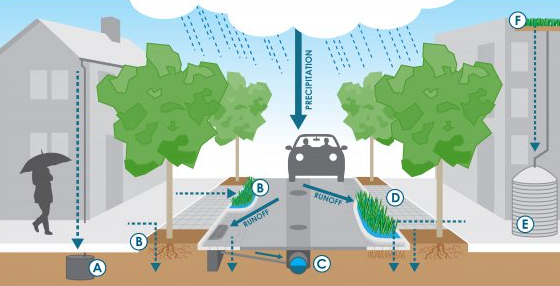How Cities Manage Stormwater Runoff

Stormwater runoff poses a significant challenge for cities as rainwater flows off impervious surfaces like roads and rooftops, causing environmental, infrastructure, and public health issues. This blog explores innovative methods cities use to manage runoff, the obstacles they face, and solutions for creating more resilient urban communities.
Why Managing Stormwater Runoff Is Critical
Before we jump into city-wide solutions, it’s important to understand why stormwater runoff is such a pressing issue.
Environmental Risks
Stormwater picks up pollutants like oil, heavy metals, pesticides, and trash as it flows across urban landscapes. These contaminants often end up in local water bodies, degrading aquatic ecosystems and threatening wildlife.
Risk of Flooding
When city drainage systems are overwhelmed, stormwater accumulates on streets, causing localized flooding. This can disrupt traffic, damage property, and even prompt costly repairs.
Public Health Concerns
Polluted runoff compromises the quality of drinking water sources, making water treatment more expensive and difficult. Furthermore, stagnating stormwater in certain areas can become a breeding ground for disease-carrying mosquitoes.
Now that we’ve addressed the “why,” let’s take a look at the “how.”
Traditional Methods for Stormwater Management
Cities have long relied on conventional stormwater infrastructure to direct and mitigate runoff. Below are some widely used methods.
Storm Drains and Underground Pipes
The most commonly found solution is a network of storm drains and underground pipes. These systems work by channeling rainwater away from roads and buildings, directing it toward nearby rivers, lakes, or retention ponds. While efficient, traditional storm drains focus on diversion rather than filtration, sometimes allowing pollutants to reach water bodies.
Retention and Detention Ponds
Retention ponds are designed to hold stormwater permanently, providing time for pollutants to settle. Detention ponds, on the other hand, temporarily store water during heavy rains and release it gradually into nearby drainage systems. Both methods help reduce flooding risks and improve water quality.
Combined Sewer Systems
Many older cities use combined sewer systems that handle both rainwater runoff and wastewater from households. While effective in dry weather, these systems can overflow during heavy rains, spilling untreated sewage into nearby rivers. This is a significant drawback cities are actively working to resolve with strategies such as SWPPP, like those in Utah, to better manage stormwater and prevent overflow issues.
Modern and Sustainable Stormwater Solutions
Thanks to advancements in technology and environmental awareness, cities now incorporate innovative, sustainable approaches to complement or replace traditional stormwater systems.
Green Infrastructure
Green infrastructure mimics natural processes to manage stormwater while enhancing urban spaces. Here are some popular examples.
- Bioswales: Permeable, vegetated channels that catch, slow, and filter stormwater before it reaches drains.
- Green Roofs: Rooftops covered with vegetation absorb rainwater and reduce the heat island effect in cities.
- Rain Gardens: Low-lying planted areas designed to soak up runoff while beautifying neighborhoods.
Permeable Pavements
Unlike traditional asphalt and concrete, permeable pavements allow water to seep through the surface and into the soil below. This reduces surface runoff and replenishes groundwater levels, making it both an effective and eco-friendly solution.
Rainwater Harvesting Systems
Rain barrels and cisterns are being widely adopted by both individual homes and municipal buildings to collect and store rainwater. This harvested water can be used for non-potable purposes like irrigation, further reducing demand on city water supplies.
Underground Storage Tanks
Advanced underground systems are now being installed beneath parking lots and roadways to temporarily store stormwater during heavy rainfall. These tanks slowly release water into drainage networks, alleviating flooding.
Innovative Technologies Enhancing Stormwater Management
The integration of technology has completely revolutionized urban stormwater management.
- Smart Sensors and Monitoring Systems: Cities employ IoT-enabled devices to monitor stormwater levels in real-time, allowing quick responses during extreme weather events.
- Stormwater Treatment Devices: Advanced filtration technologies like hydrodynamic separators remove pollutants and debris from stormwater before it flows into natural water bodies.
- Predictive Modeling Software: Using AI, cities can predict flooding scenarios and proactively deploy resources to high-risk areas, minimizing damage.
Challenges Cities Face
Despite advances, cities still face significant challenges in managing stormwater runoff.
Aging Infrastructure: Many urban areas rely on outdated drainage systems that struggle to accommodate the increasing frequency of heavy storms caused by climate change.
High Costs: Upgrading stormwater systems, especially in densely populated areas, requires major investments that some municipalities cannot afford without external funding.
Land Use Conflicts: Integrating green infrastructure into built-up urban landscapes can be challenging and may require creative retrofitting solutions.
Public Engagement: Educating citizens about the role they can play in stormwater management, such as proper disposal of waste or installing rain barrels, remains an ongoing challenge.
A Collaborative Effort for a Resilient Future
Stormwater management cannot rely solely on municipal efforts. Collaboration among city planners, engineers, residents, and policymakers is essential. Here’s how you can contribute as an individual to this pressing issue.
- Install rain barrels to collect water for gardening.
- Avoid littering to prevent blockages in storm drains.
- Choose native plants for your yard that require less irrigation and can absorb more stormwater.
- Push for green initiatives in your community, such as rain gardens and permeable pavements.
Conclusion
Stormwater runoff management is an evolving field with new technologies and practices constantly emerging. From transforming rooftops into lush green gardens to deploying artificial intelligence in water management, cities around the world are stepping up to the challenge.


